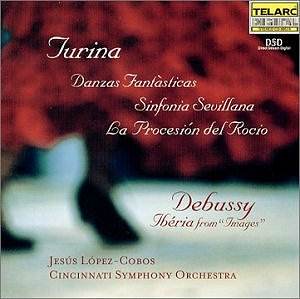As one of the less frequently heard American orchestras
I opened this disc interested to read a little about the history of
the Cincinnati Symphony Orchestra as well as their conductor, Jesús
López-Cobos. Somewhat unusually however there was nothing in
the booklet about either the man or his orchestra, despite extensive
and informative notes on the music. A shame, as on the evidence of this
recording at least, López-Cobos clearly has a very capable group
of musicians at his disposal.
It is the music of Joaquín Turina that forms
the backbone of the disc and it is also the Turina that comes off best.
Debussy’s wonderfully colourful Ibéria, which opens proceedings,
somehow fails to ignite. Even the characterful Le matin d’un jour
de fête with its pizzicato string imitations of flamenco guitars
(a slight but rather off-putting late tubular bell entry here) does
not quite get fully into the excitement and exuberance of the holiday
spirit as it could. In the central Les parfums de la nuit also,
the playing is certainly assured but does not quite capture the fragrant,
sultry atmosphere of those warm Spanish evenings in the country.
Turina’s Danzas Fantàsticas that follow
the Debussy are immediately more potent, alive and in the case of the
final Orgia, both dramatic and joyful. Manuel de Falla is present
in much of this music although his undoubted influence does not detract
from Turina’s natural melodic gifts. The opening Exaltación
is delightful, even when, as at around 0’40", the principal theme
could have been lifted straight from The Three Cornered Hat.
Written immediately after the Danzas Fantàsticas,
Sinfonia Sevillana is not so much a symphony as a set of three symphonic
pictures, all of which have strongly programmatic titles. The opening
Panorama commences mysteriously, as if through the morning mist,
before the principal theme, a unifying motto that is heard in various
guises throughout the work, announces itself. The central movement,
"On the Banks of the Guadalquivir", is an evocation
of Seville’s river, opening with a melting violin solo, which soon gives
way to the cor anglais, and complete with an undulating accompaniment
reminiscent of the motion of the water. The finale, "Festival
of San Juan Aznalfarache", is a lively dance-like impression
of a village festival, opening with a joyful triple time tune and making
considerable use of the readily recognisable motto theme from the first
movement.
La Procesión del Rocio predates the Danzas
Fantàsticas and Sinfonia Sevillana by some seven years
and is the work that firmly established Turina’s reputation in his homeland
when it was premiered in Madrid. Many of Turina’s works pay homage to
his native Seville and here again the inspiration is drawn from a religious
festival held every June, the "procession of the Dew". Cast
in two movements the work evokes the gypsy dance inspired street festivities
in the first movement whilst the second movement sees the arrival of
the procession itself, announced by pipes and drums, before a patriotic
announcement of the Spanish national anthem leads into a more reflective
passage which in turn builds to the conclusion.
The recording is exceptionally warm and rich in sonority,
perhaps too much so at times in that I found myself missing a degree
of brilliance and immediacy at certain key moments, particularly from
the brass. Nevertheless, much of the finer detail comes through with
impressive clarity and the overall impression is a pleasing one.
Christopher Thomas


